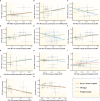Causal effects of gut microbiota on the risk of periodontitis: a two-sample Mendelian randomization study
- PMID: 37305424
- PMCID: PMC10248501
- DOI: 10.3389/fcimb.2023.1160993
Causal effects of gut microbiota on the risk of periodontitis: a two-sample Mendelian randomization study
Abstract
Introduction: The oral cavity and the gut tract are interconnected, and both contain abundant natural microbiota. Gut microbiota may interact with oral flora and participate in the development of periodontitis. However, the specific role of certain gut microbiota taxa for periodontitis has not been investigated. Mendelian Randomization is an ideal method to explore causal relationships avoiding reverse causality and potential confounding factors. Thus, we conducted a two-sample Mendelian Randomization study to comprehensively reveal the potential genetic causal effect of gut microbiota on periodontitis.
Methods: SNPs strongly associated with 196 gut microbiota taxa (18,340 individuals) were selected as instrument variables, and periodontitis (17,353 periodontitis cases and 28,210 controls) was used as the outcome. The causal effect was analyzed via random effect inverse variance-weighted, weighted median, and MR-Egger. The sensitivity analyses were conducted using Cochran's Q tests, funnel plots, leave-one-out analyses, and MR-Egger intercept tests.
Results: Nine gut microbiota taxa (Prevotella 7, Lachnospiraceae UCG-008, Enterobacteriales, Pasteurellales, Enterobacteriaceae, Pasteurellaceae, Bacteroidales S24.7 group, Alistipes, and Eisenbergiella) are predicted to play a causal role in enhancing the risk of periodontitis (p< 0.05). Besides, two gut microbiota taxa (Butyricicoccus and Ruminiclostridium 6) have potentially inhibitive causal effects on the risk of periodontitis (p< 0.05). No significant estimation of heterogeneity or pleiotropy is detected.
Conclusion: Our study demonstrates the genetic causal effect of 196 gut microbiota taxa on periodontitis and provides guidance for the clinical intervention of periodontitis.
Keywords: Mendelian randomization; causal effect; gut microbiota; periodontitis; risk factor.
Copyright © 2023 Luo, Li, Li, Zhang, Wang, Wu and Li.
Conflict of interest statement
The authors declare that the research was conducted in the absence of any commercial or financial relationships that could be construed as a potential conflict of interest.
Figures




Similar articles
-
Genetic evidence strengthens the bidirectional connection between gut microbiota and periodontitis: insights from a two-sample Mendelian randomization study.J Transl Med. 2023 Sep 28;21(1):674. doi: 10.1186/s12967-023-04559-9. J Transl Med. 2023. PMID: 37770955 Free PMC article.
-
Genetic evidence strengthens the connection between gut microbiota and gingivitis: a two-sample Mendelian randomization study.Front Cell Infect Microbiol. 2024 May 15;14:1380209. doi: 10.3389/fcimb.2024.1380209. eCollection 2024. Front Cell Infect Microbiol. 2024. PMID: 38812751 Free PMC article.
-
Causal effects of gut microbiota on the risk of chronic kidney disease: a Mendelian randomization study.Front Cell Infect Microbiol. 2023 Mar 31;13:1142140. doi: 10.3389/fcimb.2023.1142140. eCollection 2023. Front Cell Infect Microbiol. 2023. PMID: 37065213 Free PMC article.
-
Exploring the potential causal relationship between gut microbiota and heart failure: A two-sample mendelian randomization study combined with the geo database.Curr Probl Cardiol. 2024 Feb;49(2):102235. doi: 10.1016/j.cpcardiol.2023.102235. Epub 2023 Nov 30. Curr Probl Cardiol. 2024. PMID: 38040216 Review.
-
Interactive Association Between Gut Microbiota and Thyroid Cancer.Endocrinology. 2023 Nov 20;165(1):bqad184. doi: 10.1210/endocr/bqad184. Endocrinology. 2023. PMID: 38051644
Cited by
-
Large-scale genome-wide association studies reveal the genetic causal etiology between ankylosing spondylitis and risk of leukemia and lymphocytic malignancies.Front Oncol. 2024 Sep 10;14:1432664. doi: 10.3389/fonc.2024.1432664. eCollection 2024. Front Oncol. 2024. PMID: 39319060 Free PMC article.
-
Effect of the gut microbiome, plasma metabolome, peripheral cells, and inflammatory cytokines on obesity: a bidirectional two-sample Mendelian randomization study and mediation analysis.Front Immunol. 2024 Mar 15;15:1348347. doi: 10.3389/fimmu.2024.1348347. eCollection 2024. Front Immunol. 2024. PMID: 38558794 Free PMC article.
-
Genetic evidence from Mendelian randomization strengthens the causality between oral microbiome and chronic obstructive pulmonary disease.Medicine (Baltimore). 2025 Jul 25;104(30):e43347. doi: 10.1097/MD.0000000000043347. Medicine (Baltimore). 2025. PMID: 40725894 Free PMC article.
-
Infectious and Commensal Bacteria in Rheumatoid Arthritis-Role in the Outset and Progression of the Disease.Int J Mol Sci. 2024 Mar 16;25(6):3386. doi: 10.3390/ijms25063386. Int J Mol Sci. 2024. PMID: 38542357 Free PMC article. Review.
-
Causal effects of gut microbiota on autism spectrum disorder: A two-sample mendelian randomization study.Medicine (Baltimore). 2024 Mar 1;103(9):e37284. doi: 10.1097/MD.0000000000037284. Medicine (Baltimore). 2024. PMID: 38428908 Free PMC article.
References
-
- Barbe A. G., Javadian S., Rott T., Scharfenberg I., Deutscher H. C. D., Noack M. J., et al. . (2020). Objective masticatory efficiency and subjective quality of masticatory function among patients with periodontal disease. J. Clin. Periodontol. 47 (11), 1344–1353. doi: 10.1111/jcpe.13364 - DOI - PubMed
-
- Baumeister S. E., Freuer D., Nolde M., Kocher T., Baurecht H., Khazaei Y., et al. . (2021). Testing the association between tobacco smoking, alcohol consumption, and risk of periodontitis: a mendelian randomization study. J. Clin. Periodontol. 48 (11), 1414–1420. doi: 10.1111/jcpe.13544 - DOI - PubMed
Publication types
MeSH terms
LinkOut - more resources
Full Text Sources

